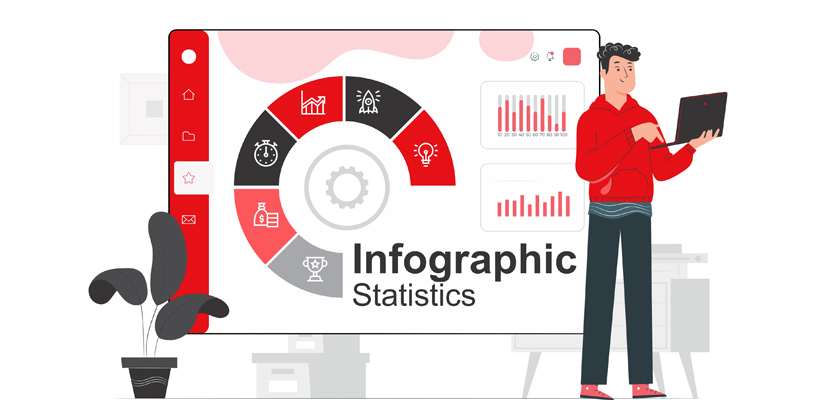30 Infographic Statistics You Need to Know in 2024

In timessss when the average attention span is decreasing, infographics are helping markets convey powerful messages. Check these infographic statistics & learn upcoming trends to try. Read now!

In timessss when the average attention span is decreasing, infographics are helping markets convey powerful messages. Check these infographic statistics & learn upcoming trends to try. Read now!
As years pass, the average human attention span is decreasing significantly, too, making it crucial for marketers to come up with engaging strategies to keep their customers interested till the very end.
Infographics, over the years, have become an increasingly used tool to gain the attention of the target audience and convey vital pieces of information using virtual elements. Most infographics are adorned with eye-catching designs and colors that are aesthetically pleasing as well as hard to miss.
In fact, infographics have become so popular that they are now used as a tool to market products, explain otherwise complicated concepts, and even to issue instructions. But are infographics the right format to convey information? And are they really an effective marketing tool?
These statistics prove just how effective infographics are and the trends you must look for:
The colors used in the infographics have a serious impact on how the target audience perceives them. Attractive colors not only grab the attention of users but also make it easier for them to read what’s written in the infographic. This makes it crucial to carefully select colors that convey a strong and powerful message without compromising on the readability of the text. Many markets are now investing time in carefully picking colors to ensure their brand comes across as confident, reliable, and trustworthy.
Processing visual elements is much easier for the brain than understanding information presented in text form. Due to this, infographics are more effective than other formats of communicating information. It is still crucial to not overload designs with bulky texts and instead adhere to keeping text to the point and easy to read.
These are some infographic trends that you can consider using to your advantage:
Data interpretation is a complex process that many people avoid getting into, especially when they are looking for vital pieces of information urgently. Infographic designs break this gap by making it possible for marketers to show data in an attractive and simple-to-understand manner.
For instance, The World Heart Federation shows the graveness of cardiovascular disease and risk factors.
Here’s another infographic from Visual Capitalist, showing how the population has grown over a period of 50 years. The infograph shows a running track and vivid colors.
Artificial intelligence has been all over the place, and its use for marketing purposes is no surprise. Many marketers resort to using AI tools to condense information pieces and turn them into infographics without requiring them to go through the whole process of designing and editing.
AI is a powerful collaborator that pairs well with human intelligence to create relevant outcomes. In fact, AI infographic generators can be used to add more life to dry designs, adding more life and making them immensely captivating.
For instance, Canva’s AI assistant, known as ‘Magic Studio,’ has a host of tools that can be used to create artistic and color designs within minutes. The tool’s incredible time-saving and versatile features can be used to arrange data and information in an aesthetically pleasing format.
Personalized designs can add more uniqueness to your data or information while also making them easy to remember. Besides, certain topics do need personalization to leave a lasting impression on the reader.
For instance, The Tea Republic used an infographic to lay out the history of tea. The side-by-side comparison of year and corresponding development makes it easier for the readers to understand how tea came to be.
Here’s another infographic showing the popular beverages that people like to order at the bar. The creative way of putting information is not only memorable but also relates to the theme of the infographic.
Infographics allow a business to create content that anyone can access by making designs that are clutter-free, fonts that are easy to read, and information pieces that can be understood easily. Providing alternative text and making interactive infographics easy to access for people with disabilities will enable your brand to reach a wider audience, enhance the user experience, and demonstrate a commitment to inclusivity and accessibility.
For instance, the infographic used by CDC is clear to read as it outlines what needs to be done and tips on staying safe during the cold season.
Bold typography, which uses oversized font styles, unexpected placement of information, and dynamic spacing between content pieces, presents information in a way that demands attention. The designs are often mesmerizing and do not necessarily have to align with the business’s brand compass, allowing more experimental freedom.
For instance, the following infographic talks about being safe when using social media. To catch attention and make people want to read, vibrant designs and colors have been used.
Infographics have been around for a long time for the convenience they offer when it comes to storytelling. They are easy to create and enable precise understanding of information. Besides, the extensive freedom to be creative allows marketers to experiment with different designs that make information more accessible, understandable, and shareable. From social media growth to driving traffic to websites, infographics are a powerful visual tool that enables businesses to capture user attention instantly.
SEO Revenue Generated
Leads Generated
For E-commerce Clients